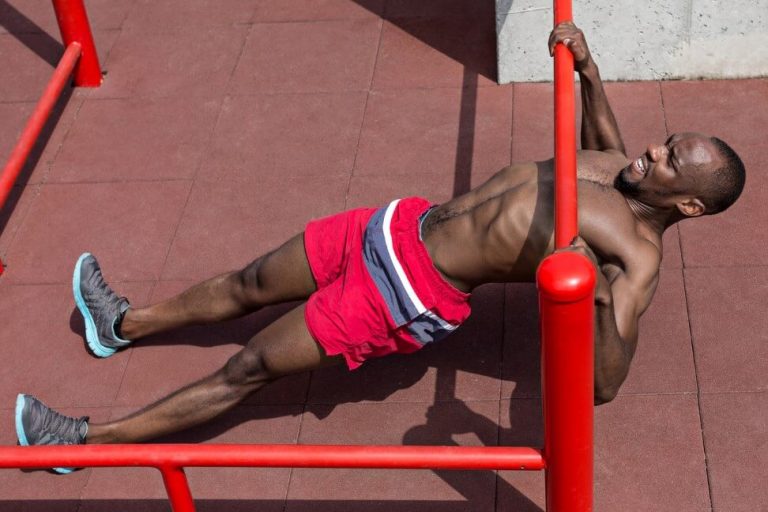Dead Hang – Excellent Exercise For Your Upper Body Strength
Dead hang is a great upper back exercise. It will help you prepare your body for more advanced hanging exercises like pull ups and chin ups. It’s fairly easy to do.
It will require some basic grip strength, and shoulder mobility to be able to pull it off.
When I started I couldn’t do a dead hang. I had a history of shoulder injuries. As a result, I went through stabilization surgery on both of my shoulders.
I missed both the strength and shoulder extension needed to do this exercise. But I did some basic preparation. After only a few weeks, I was able to pull it off.
What is a dead hang
Dead hang is a bodyweight exercise. You hang from a bar with your arms grasping a bar and your feet off the ground. It is an isometric exercise that works your grip and arm strength.
To perform a dead hang, find a pull up bar from which you can hang. Ideally, you should hang with your arms fully extended without your feet touching the ground.
Engage your core and keep your body straight as you hang from the bar. Hold this position for as long as you can.
It’s important to keep your shoulders relaxed. Try to keep your body tight. Don’t swing or bounce while performing the exercise.
Dead hangs can be a good way to improve your grip strength and upper body strength. They can also be used as a warm-up exercise before other activities.
Equipment
To perform a dead hang you will need to find something to hang from. It would be best to hang with your hands fully extended and without your feet touching the ground. This can be a pull up bar or a tree branch.
So, the most common piece of equipment needed for a dead hang is:
Dead Hang Benefits

Some of the benefits of a dead hang are:
- Improved grip strength: Hanging from a bar requires basic grip strength. Regularly doing dead hangs can help to improve your grip.
- Improved upper body strength: Dead hangs work many of the muscles in the upper body. This includes the biceps, forearms, and shoulders, and can help to improve your overall upper body strength.
- Increased flexibility: Hanging from a bar can help you increase flexibility in the shoulders and wrists.
- Improved posture: Dead hangs improve the strength of the muscles in your upper back and shoulders. This can help you improve your posture.
- Beginner friendly: This exercise is relatively easy to do. So, it’s one of those beginner friendly exercises you can do when you start your fitness journey.
It’s important to use proper form when doing dead hangs to avoid injury. Make sure to keep your shoulders relaxed and avoid swinging or bouncing on the bar. Start with shorter hangs and slowly increase the duration as you get stronger.
Prerequisites
Dead hang is a simple skill that can be performed by almost anyone. It doesn’t matter if you are just starting out or working out for years.
There are almost no prerequisites for performing a dead hang. If you can hold your arms straight above your head and have a basic grip strength to hang, you can do it. But, it is important to use the proper form to avoid injury.
Remember to listen to your body. Stop if you experience any pain or discomfort. As with any exercise, it is important to consult your doctor before starting a new workout routine or trying a new exercise.
Dead hang muscles worked

A dead hang is an exercise that involves hanging from a bar with your feet off the ground. It primarily works the muscles in your upper body, including your:
- Upper back: The muscles in your upper back, mostly your latissimus dorsi are the primary movers. They are the most important muscles involved in hanging exercises.
- Forearms: The muscles in your forearms help you grip the bar during the exercise.
- Biceps: You are not moving your body up to a bar like in chin ups or pull ups. But, your biceps will still help you hold your body in a hanging position.
- Shoulders: Your shoulder muscles help you support your body weight while you hang from the bar.
- Core: Your core muscles help you maintain a good posture while you hang. They also help you keep your body still.
Overall, a dead hang is a great exercise for improving the strength of the muscles in your upper body. Mostly your upper back, arms, and shoulders.
How to do a dead hang
Find a pull up bar, rings, or other equipment that you can hang from. This is how you do it on a pull up bar.
Positioning:
Grab a pull up bar with your arms a bit wider than your shoulder width. Your palms should be facing away from you.
Performing:
Hang freely from a bar with your feet clear from the ground. Keep your body straight and tense as you hang from the bar.
Try to hold the position for as long as you can. Keep your shoulders relaxed and your arms straight.
It’s important to keep good form when doing a dead hang. Make sure to engage your core and keep your body straight. Avoid swinging or kipping, as this can put a strain on your shoulders. This will increase the risk of injury.
Progression / Regression
If you find a dead hang too difficult, you can also try using an assisted dead hang. This is where you use a resistance band to help reduce some of your weight. It will help you build up strength and endurance. This is only if you need to slowly build the strength needed to do it without a band.
There are also other low bar exercises you can do to improve your strength:
As you get stronger, you can try hanging from one arm. You can also add weight to increase the difficulty of the exercise. Or you can try some other more difficult skills from a muscle up progression:
Key takeaways
Dead hang is one of the basic exercises that need a bit of grip strength and shoulder mobility. Even though it’s pretty easy to do, it will require some strength and flexibility to pull it off.
There are also some easier skills you can do to build up your strength and improve your shoulder mobility.
When you increase the length of your dead hangs, you will become stronger. This will prepare your body for harder skills like pull ups and chin ups.







